Exhibition labels
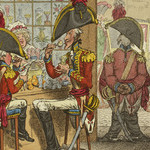
98: Hero's recruiting at Kelsey's
Hero’s recruiting at Kelsey’s; -or- Guard-Day at St James’s This satirical print (about the British army during the Napoleonic Wars) was published just 3 months after the letter confirming Perrin’s acquisition of 54 new enslaved people for one of his...
200: Expenses for a feast for the executors of Lady Margaret Beaufort, Countess of Richmond and Derby (1443 –1509)
This bill itemises all the costs for the feast that marked the winding up of the estate of Lady Margaret Beaufort (mother of Henry VII and grandmother of Henry VIII). Over £1,000 in today’s money was spent on beef, mutton,...
Transcription of the expenses
The expences of this dener [dinner] The expences of this dener [dinner] In bred ij dos. di [half] and ij peneworth [pennyworth] ij s. viij d. In ale ij kyldekyns ...
201: Commons Book 1579 – 80
In the sixteenth century, King’s College was one of the richest in Cambridge, with about 30 estates in freehold ownership. Book- keeping for so many estates, and an institution of almost 100 men, was a complex affair and the Commons...
202: List of infringements relating to the sale of food at Stourbridge Fair
List of infringements relating to the sale of food at Stourbridge Fair From the late Middle Ages until the mid- nineteenth century, the regulation and sale of merchandise in and around Cambridge were controlled by the University. The Commissary’s Court...
203: Isaac Newton’s notebook, 1659 – 61
Newton started at Trinity College, Cambridge, in June 1661, bringing with him this old school notebook filled with notes on Latin grammar. Turning it upside down, he used the empty pages at the back to record his ‘personal expenses’ during...
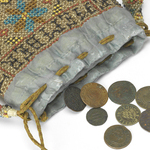
204: Pocket (purse) with draw strings
This colourful beadwork purse acted as a reminder of the importance of charity and a public expression of piety, clearly expressed by the 2019-12-04-s, ‘REMEMBER THE POORE’. Every time the owner dipped her gloved hand inside to remove a coin,...
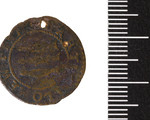
205: Token/halfpenny with three fish
From 1649 (the year of Charles I’s execution), thousands of tradesmen issued tokens for the penny, halfpenny, and farthing. Most were produced unofficially for individual tradesmen at the Royal Mint, and used as small change. Tokens often have designs representing...

206: Coffee shop token/halfpenny with a coffee pot
The Fitzwilliam Museum has several tokens for local tradesmen relating to food. This one, inscribed ‘John Marston in Trumpington Street, Cambridge’, has a hand pouring coffee from a pot into four cups set on a table. The exact location of...

207: Baker’s token/halfpenny with a decorated pie crust
Robert Millard was a baker based in Caxton in the second half of the seventeenth century. His halfpenny token proudly declares his name and profession in elegant capital letters encircling a beautifully decorated round pie crust. Following Millard’s death in...

208: Token/halfpenny with a plaited loaf represented as a group of lozenges
Thomas Powell’s halfpenny token is decorated with nine lozenges in a diamond formation, probably representing a stylised plaited loaf. Since this device appears on other tokens where the issuer describes himself as a baker, it is likely that this was...

209: Token/halfpenny with three coneys
The inscription on Hugh Conny’s token reveals that he operated in Caxton and Elsworth, neighbouring villages 9 miles west of Cambridge. The design of three rabbits, or coneys, is a play on his surname, but whether he actually traded in...
210: Account book of G. Woollard, Grocer, Trinity Street, Cambridge, 1788
Perhaps the largest and most prestigious grocer’s in eighteenth-century Cambridge was Woollard’s, located just off Market Hill, at 6 Trinity Street. Popularly known as ‘The Fortnum’s of Cambridge’, Woollard’s sold a wide range of goods. Many of the well-heeled shoppers...

211: Cambridge Market place
This image gives a good sense of the hustle and bustle of Cambridge’s central market place prior to the devastating fire of 1849 and the removal in 1855 of the original stone fountain, which had issued fresh running water, brought...
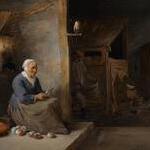
150: Interior, with an old woman peeling apples
Interior, with an old woman peeling apples This bustling scene gives rare insights into food-making activities at the ‘backside’ of a house. Neither strictly kitchen nor farmyard, such liminal spaces were used for the dirtier and messier work of food...
151: A kitchen interior with a maid filleting fish at a table
A kitchen interior with a maid filleting fish at a table This painting depicts an orderly Italian kitchen. Its white-washed walls are covered with neatly hung and scrupulously polished cast-iron and brass cooking vessels and some blue-and-white earthenware dishes, decorated...
152: A noble book off cookry
Anonymous, ‘A noble book off cookry ffor a prynce houssolde or eny other estately houssolde’ (England, c.1480 –1500) Kept at Holkham Hall, Norfolk, this is one of the best-preserved early English cookery books in existence. Hand-written in Middle English, it...
153: Anonymous, A Proper newe Booke of Cokerye (London, c.1558)
This is the only known example of the c.1558 edition of A Proper newe Booke of Cokerye, a popular cookery book designed for ‘middling’ households. It was owned by Matthew Parker, Master of Corpus Christi (whose silver is displayed at...
154: Bartolomeo Scappi, Opera
Bartolomeo Scappi, Opera (Venice, 1570) This first edition of Bartolomeo Scappi’s Opera was given to the University by George I. Scappi was an early celebrity chef, whose credentials as personal cook to Pope Pius V are proudly announced on the...
155: Anonymous
A Closet for Ladies and Gentlevvomen or, The Art of Anonymous, A Closet for Ladies and Gentlevvomen or, The Art of Preseruing, Conseruing, and Candying (London, 1608) This book, which included confections and sugar-work related to banqueting, was particularly associated...
156: Robert May, The Accomplisht Cook
Robert May, The Accomplisht Cook, or the Art and Mystery of Cookery (London, 1685) In 1660, the Catholic chef Robert May published The Accomplisht Cook, which quickly became a best-seller. May had operated as a chef in elite households for...
157: Replica Italian cook’s knives, based on illustrations in Scappi’s Opera
Replica Italian cook’s knives, based on illustrations in Scappi’s Opera These are modern replicas of the cook’s knives illustrated in Scappi’s influential cookery book (displayed below). The different blades – kept scrupulously clean and lethally sharpened – all had different...
158: Spitjack for roasting meat
In early modern Europe, meat was roasted over fire on spits rotated by clockwork jacks, like this wall-mounted example. It is similar to that shown fixed on the hearth in Pieter Aertsen’s Preparations for a feast (displayed at right). Skewers...
159: Preparations for a feast
Preparations for a feast This painting shows a wealthy Dutch merchant’s kitchen with a cook prepping for a feast. She is ‘larding’ a skinned hare by sewing strips of lard into its back to prevent it from drying out when...
160: Anonymous, The Lady’s Companion, vol. 1 (London, 1751)
A modern-day supermarket chicken normally comes with legs and wings ready-trussed with butcher’s string. This ensures that these mobile elements are kept tightly secured to the body to prevent them from drying out when roasted. Early modern cooks had to...
161: Tureen and cover in the form of a trussed roast capon
In the late 1790s flour was in short supply and the Royal Household forbade its use for pastry. Potters such as Turner and Wedgwood responded by making stoneware dishes to mimic pie crust, and hence why it was known as...
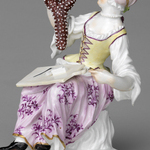
162: Female cook holding a larded hare Meissen Porcelain Factory
Female cook holding a larded hare Meissen Porcelain Factory, Dresden, Germany, c.1750; Model by Johann Joachim Kändler (1706 – 75) Hard-paste porcelain painted in enamels, gilt Given by Lord and Lady Fisher through the National Art Collections Fund (C.8-1954)
163: Larding pins and case Continental Europe
Larding pins and case Continental Europe, mid-18th century Pins: tinned steel; Case: olive wood Private collection Larding a skinned hare involved ‘embroidering’ little strips of pork fat (lardons) into its back and hind legs to stop it drying out when...
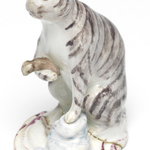
164: Seated cat holding a trapped mouse
In early modern Europe, cats were kept primarily as ‘food guardians’ to prevent vermin from eating provisions. Some earned their keep as mousers, such as this tiny feline whose mouse-catching abilities have been immortalised in soft-paste porcelain: with one paw...
165: Kitchen utensils, meat, and vegetables
Kitchen utensils, meat, and vegetables This painting celebrates local autumnal produce, including pumpkins, cabbages, apples, and a late pea crop, sown in July and harvested and dried in October for the store cupboard. Herring, a mainstay of the Dutch economy...





